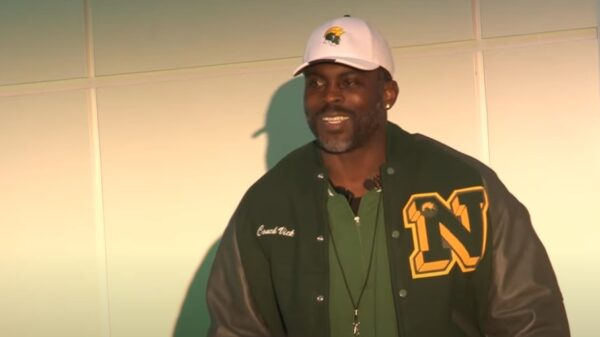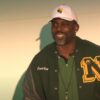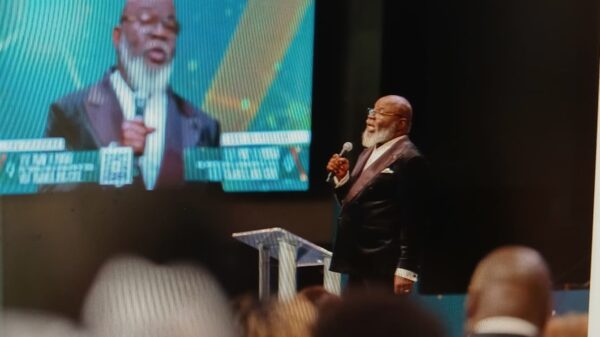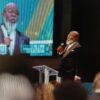On March 17, 1966, Dr. Martin Luther King Jr. appeared at Southern Methodist University to deliver a landmark speech. He began by saying the question he was asked most often:
“Are we making any real progress in race relations?”
It is, King said, “a poignant and desperate question on the lips of thousands and millions of people all over this nation.”
Before he spoke to the standing-room-only crowd,King requested a private audience with Jerry LeVias, a 19-year-old freshman who would soon emerge as a barometer of how much progress was being made, on the Park Cities campus of SMU, in the city of Dallas and in America. The 5-foot-7, 140-pound wide receiver from Beaumont had recently become the first Black athlete in the history of the Southwest Conference to be awarded a scholarship to play football.
It was a staggering responsibility to place on the shoulders of LeVias, who had left the comfort of a loving home and a Black high school to stare racial injustice in the eye. The hate LeVias faced was getting to be too much. He was thinking of leaving the school, having already encountered racism on the practice field, where a freshman teammate had spit in his face and broken his ribs. King, aware of the sacrifices LeVias was making to advance the cause of civil rights, asked to meet with the teenager. And he insisted on privacy.
About 15 minutes before the speech, SMU President Willis M. Tate and Dean of Men Joe A. Howell led LeVias to a private room behind the stage of McFarlin Auditorium, where King and several other men, security guards and fellow ministers, had surrounded the civil rights leader. King asked everyone to leave and told LeVias to take a seat. He then began speaking, in soft measured tones.
LeVias says it was hard not to let his emotions carry him away. This was the man who made the immortal “I Have a Dream” speech, who made LeVias’ mother and grandmother cry with pride.
King wore what he always wore — a dark suit, dark tie and white shirt. “Walking into the room, I felt so awed, and there we were, by ourselves. He was bigger than life to Black people. He had gotten more attention and visibility than any Black person ever had. And he was talking to me. And it meant so much. I had grown up in a religious family, and here I was talking to the Rev. Dr. Martin Luther King. I wouldn’t call him smart — I would call him incredibly smart and God-like.”
Much of what King said is now a blur to the 76-year-old LeVias. But — as the country observes King’s birthday — a few snippets remain clear.
LeVias says that in the fragile racial climate of 1960s America, King wanted no one to believe the young athlete was “a plant,” placed on the roster of an intercollegiate football team in a contrived attempt at social change.
For nothing was further from the truth.
A difference maker
Six months to the day after meeting King, LeVias would for the first time step on the emerald-green grass of the Cotton Bowl, en route to leading SMU to its first conference championship since 1948, when Doak Walker, a white player from Highland Park, had done the same.
For LeVias, the narrative was destined to be different, as King had anticipated.
He left LeVias with a firm handshake and the best advice LeVias says he’s ever heard: “Always keep your emotions in control.”
King’s words echoed those of Ella LeVias, the player’s grandmother and lifelong protector, with whom he prayed on a daily basis. She insisted he wear only one number at SMU, 23, in honor of their shared mantra, the 23rd Psalm.
As a teenager, LeVias had no idea how soon he’d become the football embodiment of the prayer that calls for faith in the face of struggle and pain. Somehow, some way, he says with a wry chuckle, King knew. Speaking with King was something LeVias says he’ll never forget.
/cloudfront-us-east-1.images.arcpublishing.com/dmn/LNDZOL5XBFGZTB4D4FN7BQE3MI.jpg)
Rufus Cormier, a Black high school classmate of LeVias’ — who, one year later, joined the SMU roster as a teammate — says LeVias was destined to make history for reasons having to do far more with character than football.
He was, Cormier says, “rigorously screened by Coach Hayden Fry,” who already knew of “the challenges Jerry would face. His athletic achievements were astonishing, but that is not the only, or even the primary reason, that Jerry is so deserving of admiration and respect.
“Jerry’s intelligence, fortitude, integrity and devotion to excellence, together with his mythic athletic ability, made him the ideal candidate to open the doors to integration. Jerry was in many ways a Jackie Robinson. He endured with courage, grace and dignity the threatening phone calls, racist letters, isolation and other intimidation he encountered, to which a lesser man would likely have succumbed.”
Polio and a stroke
Shy and quiet, LeVias grew up in a loving family, anchored by a grandmother whose spirituality defined not only her life but his. His father was a laborer, his mother a housekeeper, who worried most of all for his safety.
Jerry was the youngest of three children, “the baby,” he says, who in many ways appeared ill-cast as a civil rights icon. As a child, he endured polio and a stroke before being picked for the football team in his hometown, where coaches had long believed he was too small to play. By his fourth-grade year, LeVias had healed but “had to run home every day, otherwise kids would beat me up.”
That as much as anything, he says now with a laugh, helped him hone a rare athletic talent. “I was fast.”
/cloudfront-us-east-1.images.arcpublishing.com/dmn/7RXTXCCDE5HDBE6FSBHVJPKBNQ.JPG)
Of all his grandmother’s grandchildren, “I was the smallest,” he says. “Grandma would pray for you, and we believed she had a direct connection to God. Because when Grandma said something, it was good. We believed in Grandma. So, when Coach Fry came to the house, he had done his homework. He talked to all the coaches and everybody who knew us.”
Fry, LeVias says, spoke Grandma Ella first, before he conversed with Jerry’s mom or dad.
LeVias not only graduated from SMU, he did so proudly, as an All-American on the field and an Academic All-American off. He says he harbors not one bad memory of SMU academically. He adored his professors, most of whom have passed away but who steered him to a life after football, as an executive with the oil and gas company Conoco and later as the head of his own marketing company.
R. Gerald Turner, the president of SMU, lists a multitude of reasons why LeVias is among SMU’s Distinguished Alumni, an honor he received in 2006.
Turner calls LeVias’ contribution to the school and its history “incredibly important. Because it has in it all of the issues and emotions that made up the 1960s.” The fact that Jerry, in terms of racial equality, “was leading the way in the Southwest Conference is one of those important components of our history.”
Anytime “you’re a first and having to deal with the pain that goes with that” is, Turner says, both lasting and significant. “You’re first, because there have been a lot of forces that have kept it from happening before. And so, all of those forces come to bear. It’s painful to me to read Jerry’s report of those times. But it makes you incredibly proud of him.”
A prized recruit
Before agreeing to play at SMU, LeVias received close to 100 offers from colleges including UCLA, where his cousin, Detroit Lions great Mel Farr, and even Jackie Robinson had starred. Not one offer had come from the Southwest Conference.
Fry, who became the Branch Rickey in SMU’s version of the Jackie Robinson story, had recruited LeVias with a rare passion, believing it was not only the right thing to do — that Black athletes had long been deprived of their rightful place in college sports, especially in the South — but that LeVias in particular could elevate small, private SMU to an equal status with conference juggernauts Texas and Arkansas, which had each ascended to a national championship in the 1960s.
Max Woodfin, a freshman during LeVias’ 1968 senior season, understood the pressures LeVias faced in a sea of white students, including himself. Woodfin, who grew up in the rural environs of Brinkley, Ark., says, “A lot of us came from high schools that were still segregated. I was in the first integrated graduating class from my high school in Arkansas. So, being around Black students in the classroom was a novel experience.”
Once he arrived at SMU, Woodfin learned that the problems of race relations extended beyond SMU to Dallas as a whole. As a freshman, he was assigned to cover some of Dallas’ first integrated high school games for a downtown newspaper. “It was not a pleasant place for a Black player,” he says. Woodfin routinely heard racist slurs “not only from the fans but even from people sitting in the press box.”
But the tide was starting to turn.On the housing questionnaire Woodfin filled out three years after LeVias was admitted, “One of the questions was: Would you accept a roommate from another race or nationality?”
Even before LeVias took the field in 1966, Black players had introduced interracial rosters to local fans of professional football. The Dallas Cowboys and Dallas Texans, who in 1963 became the Kansas City Chiefs, began playing in the Cotton Bowl in 1960. The Cowboys’ roster included such All-Pro talents as Bob Hayes and Cornell Green, who were Black, as was Texans’ running back Abner Haynes.
All of which failed to lessen LeVias’ pain. As heonce told Arnold Payne of WFAA-TV (Channel 8), his years on The Hilltop were “a living hell.”
“It was,” he said to Payne, “a nightmare. You weren’t treated right, you weren’t treated equally, you were lonesome. Being spit on, you were called the N-word, an African, a monkey. The times when people would call me a [N-word], I would look at them, smile and say, ‘The best one you’ve ever seen.’”
In those days, freshmen were not permitted on the varsity roster. So, LeVias did not appear in a varsity game until his sophomore year, which began with SMU trouncing Illinois. Led by LeVias, SMU finished with a won-lost record of 8-2, before losing to mighty Georgia in the annual Cotton Bowl Classic, SMU’s first appearance in 18 years.
Campus hero? No. The racist ugliness had actually begun the year before, perpetrated not by an opponent but by a teammate.
“My first game, my freshman year, I made my mark, but they beat me up in practice so bad.”
Freshmen had their own squad, which then-36-year-old Fry did not coach, meaning he wasn’t around to protect his recruit.
“I realized, this was going to be tough, when your own teammate spits on you, and you’re on the ground, about to get up, and then he kicks you in the back and breaks your ribs,” LeVias says.
Off the field, it was at best a mixed bag.
When LeVias arrived on campus in the fall of 1965, a graduate of all-Black Hebert High School in Beaumont, he did so as one of two Black students at SMU. Assigned a white roommate, it appeared to be going well. For about a month.
/cloudfront-us-east-1.images.arcpublishing.com/dmn/FVC3SZ53HRECFJRG6GEEQ2ENBE.jpg)
“I thought we got along pretty good. No problems,” LeVias said.
But one day, after practice, LeVias got word that Joe A. Howell, SMU’s “dean of men” wanted to see him.
“He told me what it was,” LeVias said, “that the white kid wanted to move out.”
How did that make him feel?
“It’s something I’ve had to deal with my entire life,” he says. The white student who no longer wished to share a room with LeVias moved to the dorm room next door.
And then, “it happened to me again” during sophomore year.
At least that student, LeVias says, “was man enough to tell me he had to move out, because no one wanted to be his friend anymore, and ‘no girl wants to date me.’”
The prophetic King
For all four years at SMU, LeVias lived alone. Those years, he says, marked the beginning of an almost-crushing feeling of loneliness and alienation that lingered well into adulthood. In a way, King had left him with a double burden — to not only endure the racist abuse but to remain stoic no matter how much it shook him.
“As far as my teammates were concerned, I was only good for Saturday.” The rest of the week? They weren’t that friendly. “Later on, if Otis Redding or James Brown was in town playing a concert, and they needed an escort in a Black part of town, well, then,” LeVias says, “yes, they would hit me up.”
To ease the loneliness, LeVias sought refuge in the blues clubs and Black homes of South Dallas, but at times, his own feeling of blues was sharpened. Some expressed skepticism as to why a young Black man would agree to play at a privileged school dominated by whites. “Some,” he says, “even called me a traitor.”
“My mother’s sister lived in Dallas, and I would go there on weekends to spend time with my aunt and uncle,” he says. “Because there was nothing else for me to do.”
The lowest points, he says, were getting hurt, having no one to room with and watching racism creep into the classroom. “On the first day of class, students would sit on the floor, just to avoid sitting by me.”
/cloudfront-us-east-1.images.arcpublishing.com/dmn/JTGTP5JGHBAPVAYTJ7BXNI33XA.jpg)
Three times, in driving back to SMU from South Dallas, he was stopped by police for one reason — he was Black. Had it not been for the kindness of professors, and a Jewish family that offered the shelter of a loving second home, “There is no way on earth I ever would have made it.” To this day, he wears a Jewish Star of David with a black sapphire in the middle to honor that family’s kindness.
“I didn’t have any campus life. I didn’t have college life. My friends on campus were the janitors and the cooks.”
Even so, when it came to recruiting Black players, Fry didn’tstop with LeVias. By the time he joined the varsity team as a sophomore, LeVias welcomed the arrival of Cormier and running back Walter Haynes.
They roomed with each other, not with LeVias. But all three grew close. Cormier went on to attend Yale Law School with Bill and Hillary Clinton before becoming a distinguished attorney. Haynes, a former reporter at the Boston Globe, died in 1981.
“He instinctively knew that opportunities for others, like me, who followed at SMU and other Southern colleges and universities, were dependent upon his success,” Cormier said of LeVias. “If he had not thrived both academically and athletically, Coach Fry could not have recruited me or those who followed.”
‘It broke me’
On Nov. 26, 1966, during LeVias’ first varsity season, with a record of 7-2, SMU needed only a victory in Fort Worth against Texas Christian University to capture its first conference championship since 1948.
When SMU’s bus arrived, “I’ve got policemen escorting me into the stadium,” LeVias says. “I’m thinking, ‘Big game, movie star, red-carpet treatment. Everything! I’m huge. I’m the star.’ “
But that wasn’t the reason for the beefed-up security. As the HBO documentary Breaking the Huddle noted: “A phone call to the university warned of a possible tragedy.”
LeVias told HBO, “The threat was that I was going to be shot. And there’s going to be a sniper in the stands.”
Even so, LeVias played, catching a 65-yard touchdown pass and leading SMU to the conference crown. The Mustangs ended the season ranked 9th in the nation.
But racist attacks continued.
During his junior season in 1967, at a road game in Waco, a player for Baylor University stuck his hand through LeVias’ face mask and, with his thumb, tried to gouge out LeVias’ eye. He almost succeeded. It ended LeVias’ season. Only surgery saved the eye.
During his senior year in 1968, in a game at the Cotton Bowl, a player for TCU rolled on top of him, spit in his face, and made “some real strong racial remarks,” as Fry would later say.
That one marked the breaking point for LeVias. As he told HBO, “I lost it. I quit. I came to the sidelines. I threw my helmet down. I told Coach Fry, ‘I don’t have to take this s—. I quit!”
He returned to the field, fueled by an emotion that he had until then suppressed: hate. With the score tied, 14-14, LeVias fielded a punt and, zigzagging acrobatically from sideline to sideline, scampered more than 80 yards to the end zone. SMU won, 21-14.
He calls it his worst touchdown ever, “because it broke me. I did it out of hate.” It became, he says, “the first time I’ve ever really hated white people.”
In later years, it represented a breakthrough. Hate, he says today, is no more than a cancer, consuming not the target but the hater. The metaphor rings with the virtues King espoused, to which LeVias was introduced 56 years ago.
“I’m still healing,” LeVias says. And yet, as King and Grandma would have wanted, “the hatred is gone.”
Then and now
Looking back on his meeting with King more than half a century later, LeVias says the reverend’s parting words — “Always keep your emotions in control” — remain the best directive he could have received at the time. But adhering to them took a private toll. It led to five years of psychotherapy. It also led him to the love of a wonderful woman.
/cloudfront-us-east-1.images.arcpublishing.com/dmn/RDA3RVXUU5FP5L5WKGAEM2KGRA.jpg)
Today, LeVias is happily married to Janice LeVias, his partner for more than 40 years. They live in Houston, where LeVias was drafted in the second round in 1969 by the Houston Oilers (now the Tennessee Titans), with whom he played through 1970. He played with the San Diego Chargers from 1971 to 1974.
“Janice saved me,” LeVias says, “by letting me be myself. I had so much built up, and I couldn’t talk about it to anybody. She believed in me not as an athlete but as a person.”
On Feb. 21, a historic marker will be dedicated at McFarlin Auditorium, where King delivered his speech in 1966.
It would be tempting to say nearly 60 years later that LeVias is revered on The Hilltop for his historic role in integrating college sports. But that isn’t quite the case.
Doak Walker is honored with a statue that serves as the centerpiece of Doak Walker Plaza. There is no Jerry LeVias statue and no plaza.
Turner, the SMU president, says LeVias reminds him of a line from the great novelist William Faulkner, who once said, “I believe that man will not merely endure: he will prevail.” LeVias “didn’t just endure it all,” Turner says, “he prevailed.”
So, does that mean LeVias might one day be honored with the same degree of prominence as Walker?
“The answer is yes,” Turner says. “Particularly if you’re talking about a plaza that’s directly related to him and so on. But when it comes to statuary on campus, once you start building them, it’s hard to stop. Jerry deserves some place, whether it’s a statue or not.”
LeVias’ response? “I don’t need a statue on the SMU campus. Just get them to recognize the role that Hayden Fry and President Tate played to recognize their place in the South for minority students wanting to play sports. I am not asking for attention. My success speaks for itself.”
In 2006, LeVias returned to Dallas to receive the Distinguished Alumni award. He gave a speech, during which he said, “It only takes one person to have an effect against racism. It takes many to defeat it. I look forward to the day SMU will fully understand their contributions of integrating the South.”
In 2009, then-head football coach June Jones created an award given to, in the university’s words, “a deserving student-athlete” chosen annually “to wear the number ‘23′ on his jersey to honor LeVias for his contributions to America, the sport of football and SMU.”
Last year’s recipient was Austin Upshaw, a senior wide receiver from La Porte. In August, for the first time since the award was created, LeVias came to SMU, where he presented it personally.









You must be logged in to post a comment Login